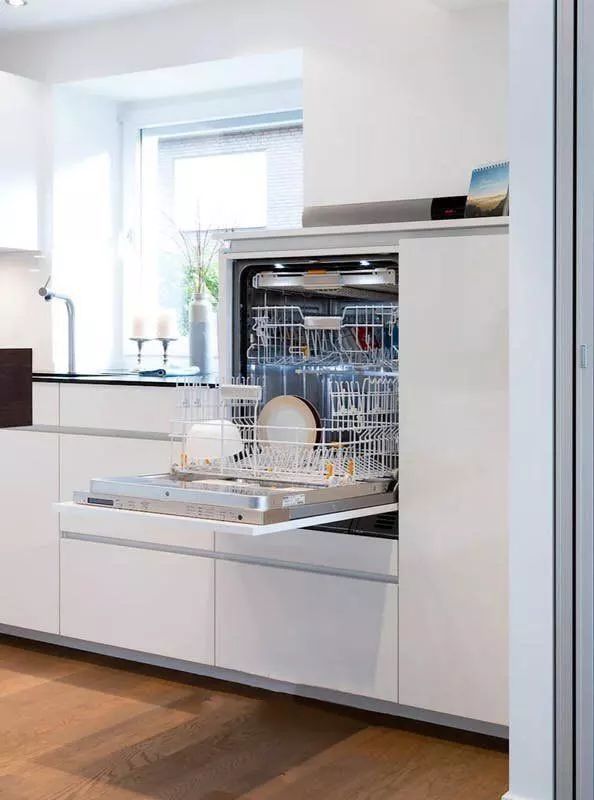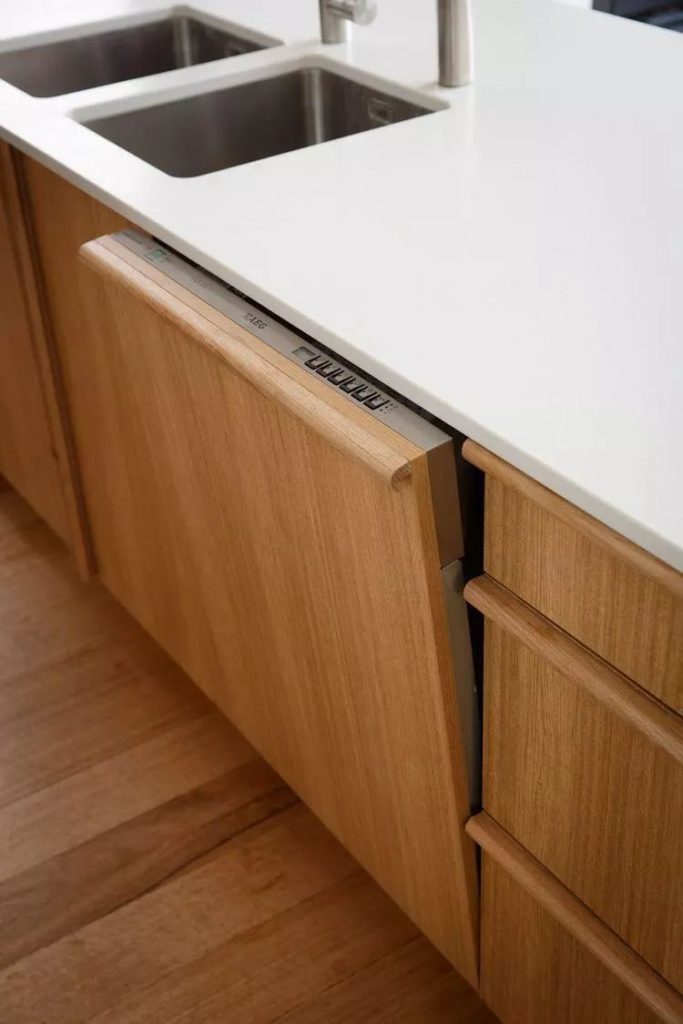My Guide to Selecting the Best Dishwasher for My Home
The first time I learned about a dishwasher was when I was in elementary school and saw it in a newspaper. I remember being amazed and thinking, “Someone is so lazy that they don’t even want to wash dishes themselves and had to invent a machine to do it…”
At that time, washing dishes was a natural thing for me. When the adults cooked and the whole family ate, it was my responsibility to wash the dishes after the meal. This was one of the few household chores I could help with at that time. As a kid, I was playful and inevitably made the pots and pans clang and clatter.
Several decades have passed in a flash, and I never expected that I would also use this “lazy” machine. Even more surprisingly, once you start using it, you can never go back to washing dishes by hand again.
1950s American dishwasher advertisement, even through the screen, you can feel the relaxed and happy feeling of housewives after getting a dishwasher.
During the renovation, I decisively chose the dishwasher between the dishwasher and the sterilizer. At that time, I wondered who invented the method of using a sterilizer in the kitchen. It was too expensive and in the end, it was just a transparent cabinet for dishes. Look at how useful the dishwasher is. If there are two or three dishes, they can be easily washed by hand. Once you make more dishes on weekends or on an enthusiastic evening, you can simply put all the cups and dishes into the dishwasher and forget about them. After one or two hours, when you open it, everything is clean and warm, and your sense of happiness is multiplied.
Although the price of dishwashers is not too expensive now, they can significantly improve the happiness index of life. However, we are not sure why the popularity rate is not high. Today’s article is a small achievement after preliminary research. We hope that if it is not too difficult, every household should have a dishwasher, which is really useful. Of course, it is not recommended to put too high-end porcelain in it, no matter what the dishwasher’s instructions say.
After finishing the meal, simply dispose of the food residue, put all the dishes and plates into the dishwasher, press a button, and enjoy a cup of tea or chat with friends. Life couldn’t be better.
Several misconceptions when choosing a dishwasher
Dishwashers have a high penetration rate in developed countries, but in some countries, they have not been widely accepted and sales are far behind other household appliances such as televisions, refrigerators, and washing machines. Even in many large cities, the penetration rate is extremely low.
There are reasons for the characteristics of dishwashers themselves. For example, as a machine used for laziness, dishwashers are far less popular than washing machines. The time for washing dishes in a single cycle is much shorter than the time for washing clothes, so the time and energy saved by dishwashers are far less than those saved by washing machines. Considering this, people are more likely to buy washing machines than dishwashers.
In addition, there are some misconceptions that hinder the popularity of dishwashers:
1.Dishwasher not cleaning well?
This is the number one misunderstanding about dishwashers. Generally speaking, the tableware standards used by Europeans and Americans, such as plates, knives, and forks, are standardized, with less contamination and easy to clean; Chinese tableware (bowls, jars, plates, basins, etc.) are deeper and more diverse in style, and Chinese cuisine is greasy and has a wide variety of ingredients. If the dishwasher does not wash thoroughly or has design problems, it is easy to cause unsatisfactory washing results. These problems did exist in the early days of dishwashers, after all, many designs were not mature at that time.
However, with the development of products over decades, whether or not it can be cleaned has long ceased to be a problem. Dishwashers use high temperatures above 70°C combined with high-pressure flushing to effectively remove stubborn grease from Chinese tableware, pots, and cooking utensils. From everyone’s experience, dishwashers are actually best at washing oily dirt, and if washed with strong force, they can even be cleaned without any cleaning agents. The most difficult to wash is protein, because protein will solidify when heated and stick firmly to the bowl, such as a bowl that has steamed egg custard.
Dishwashers not only wash visible things, but also wash invisible things. Most dishwashers heat water up to 70℃, which can effectively kill harmful bacteria such as Staphylococcus and Escherichia coli; then through drying, the surface of the tableware can be kept dry, preventing the growth of bacteria. In terms of sterilization and inhibition, machine washing has incomparable advantages over traditional hand washing.
2.Does a dishwasher waste water and electricity?
Most elderly people have almost zero acceptance of dishwashers, and the main reason is that they think the dishwasher runs continuously for one or two hours, and they believe that it keeps taking in water. In fact, the water is entered and circulated in batches, and it uses about 10 liters of water in total (depending on the model and wash cycle), and each wash only consumes less than one kilowatt-hour of electricity.
Japanese people, who care about resource conservation, conducted an experiment using five different dishwasher models to clean tableware after a meal for six people. The model that consumed the least water used about 11 liters, while the model that consumed the most water used about 22 liters. The average water consumption for ten people to wash the same amount of tableware by hand was 66.6 liters. Similar comparative experiments have also been done in China, which showed that using a dishwasher can save 3/4 of the water and 1/3 of the electricity.
There is one extra sentence, which says that if you are too frugal with water when washing dishes, it may not be a good thing.
3. Is the dishwasher very expensive?
Whether something is expensive or not depends on who you compare it to and how you compare it. Early dishwasher products were indeed expensive, and in the 1990s, prices of up to $800 made people feel the pinch: just washing dishes, and it costs so much? I could earn this money myself!
Decades have passed, and compared to the rise in income and housing prices, dishwashers are no longer considered expensive. Dishwashers on the market range from $300 to $2,000. Siemens’ basic model with 13 sets is only $500, which is not excessive compared to other household appliances. After all, a flagship smartphone now costs over $1,000.
In my opinion, the greatest significance of a dishwasher is that when you have spent half a day cooking a big meal, and have a mass of dishes left to wash but don’t want to move, you can just stack the dishes and then take a bath, watch a movie, or go to bed. This significantly increases happiness. Whether a dishwasher is expensive or not mainly depends on how you combine your own situation, and weigh whether the happiness gained is worth the money spent.
Limitations of Dishwashers
1.Food should be prepared before washing
Many people think dishwashers are useless and not worth it, mainly because they have too high expectations. Dishwashers today are not advanced enough to do everything for you. On the contrary, the pretreatment of tableware before washing and the way you place the dishes in the machine are crucial and directly affect the washing effect.
Firstly, pretreatment is important. Before putting the dishes in the dishwasher, you should remove larger food particles to avoid clogging the filter and affecting the cleaning process. Some people find this step unnecessary and prefer to wash the dishes by hand instead of using a dishwasher, but this issue cannot be solved yet.
Food residues in the bowl or plate should be processed to this degree, without any large residues.
Tableware placement is also very important. Because most dishwashers on the market use high-pressure spray to wash dishes, correct tableware placement is essential to clean dishes effectively. Whether it is a bowl rack designed for Western tableware or a versatile bowl rack designed for complex Chinese tableware, users should place bowls, plates, spoons, dishes, cups, and other tableware in the dish rack according to the position and direction indicated in the instructions for the best cleaning results. There are certain skills and flexibility required for placement, which need to be practiced and summarized regularly. For dishwashers with more than 8 sets, it usually takes 1-3 minutes to fill them properly.
Additionally, there are three types of consumables for dishwashers: softening water, cleaning, and quick-drying and brightening, which correspond to salt, detergent, and rinse aid. Nowadays, there are also multi-functional products available. The cost per use ranges from a few cents to over a dollar.
2.Not all utensils can be washed
Not all tableware can be washed in a dishwasher due to the principle of the machine. Ceramic tableware has tiny pores on its surface, and prolonged use of a dishwasher may cause surface abrasion. If the ceramic tableware is glazed with color, there is a risk of color fading or even heavy metal poisoning. If you prefer ceramic tableware, it is recommended to choose those with underglaze color, which is relatively safer. As for chopsticks, ordinary wooden chopsticks may fade or crack.
3.Dishwasher also needs cleaning after washing
This mainly refers to the fact that dishwashers cannot replace cabinets, let alone disinfection cabinets. Friends who have such expectations can dispel their thoughts.
The general maximum operating temperature of a disinfection cabinet can reach 120°C, which can ensure that the surface moisture of tableware is completely evaporated, giving a very effective feeling of sterilization. Due to the limitations of the materials of internal components, the highest temperature that a dishwasher can withstand is around 75°C. Although this temperature can achieve the basic purpose of cleaning and sterilization, it is difficult to avoid residual small water droplets on the inner liner, tableware, and basket after the washing is completed, and there may also be standing water in the drainage pipe. If the tableware is stored in the dishwasher for a long time, it will inevitably become damp, and even mold may grow. It is also inappropriate to use a dishwasher as an ordinary cabinet.
Therefore, no matter what kind of dishwasher is used, the tableware should be taken out in time after washing, or the door should be opened for ventilation. Some high-end products (such as Miele) have automatic door-opening functions, but the price has also increased.
How to buy a dishwasher
One of the first things to consider when choosing a dishwasher is its capacity. Strictly speaking, this depends on the number of people in the household, installation conditions, and budget. If we have to generalize, the bigger the better, ideally being able to accommodate both dishes and pots.
The reason why it’s important to emphasize the ability to wash pots is that it signifies that the dishwasher has enough space to accommodate tableware of various shapes and sizes. On the other hand, with a smaller capacity dishwasher, even if you arrange the dishes carefully, you may still need to spend a lot of time bending over and figuring out how to fit everything in, which can be physically and mentally exhausting.
You won’t regret getting a dishwasher with a larger capacity, but you may regret getting one with a smaller capacity. When space and other conditions allow, it’s recommended to choose a dishwasher with a capacity of 8 or 13 sets. An 8-set dishwasher has a decent volume, is compact, and saves energy and water, while a 13-set one has the largest capacity and can handle all kinds of tableware with ease. I have friends who even say that dishwashers with less than 13 sets are a rip-off, and some say that those with less than 8 sets are just toys. These are extreme opinions and are for reference only.
It would be best if dishwashers could also wash pots. For those who wash dishes, the pressure of washing pots is even greater.
2.Various Styles of Dishwashers
According to the different installation methods, dishwashers can be divided into countertop dishwasher, freestanding dishwasher, under-counter, semi-integrated, and fully integrated types. The tabletop type has little to do with cabinet design and installation. For integrated types, if you care about having a uniform cabinet panel, you can buy semi-integrated or fully integrated types. If you don’t care, you can buy any type.
Freestanding dishwasher
Embedded dishwasher with operating buttons on the outside
Embedded dishwasher with control buttons inside
Unstyled cabinet doors can accommodate built-in dishwashers.
There are stylish cabinet doors available that can also be used for built-in dishwashers.
Dishwashers don’t necessarily have to be installed under the counter, they can also be installed in the middle. The biggest advantage of doing so is that you don’t have to bend over, which can save a lot of effort. The cost is that you need to redo the water and electricity. In addition, it may affect the consistency of the appearance of the cabinet, which may not look good. Whether or not it can be done and how to do it, you need to communicate with the cabinet designer specifically.
3.Pay attention to the drying method
One of the main pain points that dishwashers solve is the greasy feeling and dripping water after hand washing. My favorite thing about dishwashers is not having to put wet dishes in the cabinet anymore. The principle of mainstream dishwashers on the market is similar, whether they are cheap or expensive, high or low-end, the main difference lies in the drying method:
Basic products usually use residual heat drying, while advanced products use methods such as heat exchange, fan drying, or a combination of multiple methods. Some flagship products of certain brands use their own research and development of more advanced methods, such as zeolite (crystal lily), perfect dry, and so on. Generally speaking, the higher the level of the method, the better the effect.
4.Buy mainstream brands and products
The principle of the dishwasher is not complicated, there is not much high-precision technology inside, and it is unlikely that there will be a sudden innovative breakthrough. When buying, we should choose well-established brands that have been thoroughly tested by the market and products that everyone is buying, and we won’t go wrong.
Dishwashers were first introduced in Europe, and people in Europe and America use them every day. We must believe that they are not foolish, and we must believe that there are specialists in every field. Siemens is down-to-earth, has guaranteed quality, and reasonable prices. According to our observations while on business trips in Europe and staying in apartments, many ordinary European families use Teka, and we occasionally see someone using Miele. As for Chinese brands, Midea has accumulated some technology and design experience due to its many years of experience in producing European products for multiple brands, which makes it stand out among domestic brands.
The biggest characteristic of Japanese dishwasher products is that they are small in size and easy to place. However, the disadvantages are also quite obvious: they are mainly tabletop (built-in ones are expensive), have a small selection range, and have obvious performance shortcomings. Overall, they are more suitable for users who have already installed cabinets and have limited installation conditions.
When choosing a dishwasher, pay attention to the main functions and experiences, such as capacity, cleaning performance, and drying performance. Don’t be swayed by peripheral functions. Some brands have launched special dishwashers, such as sink-type ones. The unique shape and installation position do bring some convenience, such as no need to bend over and convenient for washing fruits and vegetables. However, some users have complained that it has a small capacity, does not clean well, and has average drying performance. The pros and cons are obvious, it depends on how you balance them.
Countertop Dishwasher
For small families who have already completed their home decoration, a countertop dishwasher is a practical choice. It is small in size and easy to place without the need for renovation. This type of machine is more convenient for the elderly as they do not need to bend over to use it. Of course, due to its limited size, it can only wash dishes on a daily basis. If washing pots, it needs to be done in batches.
The Kapas Portable Countertop Dishwasher is priced about $300 on Amazon.
This countertop dishwasher has 5 washing programs, built-in 3-cups water tank, 3D cyclone spray.
Portable Countertop Dishwasher is priced at around $300 on Amazon.
Due to the limitations of volume and price, the overall configuration of the tabletop dishwasher is not high, and the technology is relatively traditional. For example, in terms of drying method, both machines adopt the most basic residual heat condensation drying. Of course, necessary devices are still not saved, such as both have built-in water softening devices, which make it difficult for water stains to remain on the tableware after washing and prevent the accumulation of scale on the machine’s heating element.
Dual-use dishwasher for independent/under-counter installation
Freestanding dishwashers are suitable for households that already have cabinets installed or do not want to make the countertop too high. Actually, most of these machines are both freestanding and built-in, and can be embedded in cabinets by removing the top cover. However, the overall cabinet manufacturers tend to make the countertop lower (70-80cm), while the machine body is higher (815mm after removing the top cover), making it difficult to embed in cabinets. In fact, if you are over 160cm tall, you can completely customize a cabinet with a countertop height of 85mm. Many finished cabinets, such as those from IKEA, only have specifications of 85mm and 90mm in height.
Freestanding dishwashers come in two sizes: the 45cm ultra-thin type (9 sets) and the 60cm full-size type (12-13 sets). Firstly, the choice should be based on space. If conditions permit, it is recommended to choose the full-size model. On the one hand, the space is larger, and on the other hand, washing dishes and pots is more enjoyable. In addition, manufacturers will prioritize applying new technologies to full-size models, so the product line is more abundant, and high-end models have more complete functions.
hOmeLabs Compact Countertop Dishwasher – Energy Star Portable Mini Dish Washer
SPT SD-2213W ENERGY STAR Compact Countertop Dishwasher – Portable Dishwasher with Stainless Steel Interior and 6 Place Settings Rack Silverware Basket for Apartment Office And Home Kitchen, White
COMFEE’ Portable Dishwasher Countertop, Mini Dishwasher with 5L Built-in Water Tank, No Hookup Needed, 6 Programs, 360° Dual Spray
When it comes to high-end washing machines, dryers, and dishwashers, Miele is an unmistakable brand. Miele dishwashers are all imported from Germany, and coupled with the brand’s renowned quality, there is no need to worry about the quality. However, the price is also quite high, with a fully embedded dishwasher selling for over $5,000. As for cockroaches crawling in, cough cough, how could there be cockroaches in a Miele household?
Embedded Dishwasher
For families who are about to renovate their homes, embedded dishwashers are recommended. Embedded dishwashers also come in ultra-thin, compact, and full-size models. It is recommended to choose a full-size model with a larger capacity and more complete functions as much as possible. Among them, fully embedded dishwashers are particularly recommended. The entire panel is completely consistent with the cabinet panel, and the operation buttons are hidden at the top, making the cabinet appearance fully intact and harmonious.
Full embedded dishwasher, with control panel hidden at the top. Once the machine is closed, the appearance of the cabinet is harmonious, but there is a slight sacrifice in terms of ease of operation.
The semi-embedded dishwasher has an exposed control panel, and the body and cabinet use the same panel, achieving a good balance between appearance and practicality.
Embedded dishwashers are installed inside cabinets, so the door panel is the same as the one you custom ordered for your cabinet.
Siemens SN678D16TC, 13 sets of fully embedded dishwasher, with dimensions of 598x550x815mm.
Imported from Germany, it is part of the high-end Pure series. Compared to mid-range products, its main selling points include:
① In addition to condensation and heat exchange drying, it also incorporates “Zeolith drying technology”. Siemens’ “Zeolith drying” and Bosch’s zeolite drying are the same type of technology, which adds a natural mineral with moisture-absorbing and heat-releasing properties. During the drying process, the zeolite mineral absorbs moisture from the dishwasher and releases the heat stored in the mineral in the form of hot air flow, accelerating the dish drying process and helping to save water and electricity.
② It has eight washing modes, such as Crystal Washing, which adjusts water temperature, water pressure, washing and drying time, and is especially suitable for fragile or heat-sensitive glass, plastic, bone china, and crystal dishes.
③ It has a higher-end operation and display design. It has a full-color Chinese display TFT touch control screen, a blue ambient light that automatically turns on after opening the door, and the dishwasher can project real-time operating information onto the ground, solving the embarrassment of not being able to see the display screen after closing the fully embedded dishwasher.
④ It includes home networking function, which allows remote control of the dishwasher through an app.
SN678D16TC belongs to the Zhenjing series dishwasher, with a retail price generally above $1500. It has a more innovative appearance, more washing modes, more comprehensive drying function, and more diverse operating methods. In terms of core aspects such as cleaning, drying, water saving, and time saving, the flagship series has made some breakthroughs, but it is not a qualitative change. Some additional functions may not be used frequently. For example, in most households, various dishes and even pots and pans are usually mixed for washing, so various special washing modes are not used very often. Another example is the function of remote control of the dishwasher through a mobile phone. In fact, you still need to load and unload dishes and add detergent by yourself. So, is it more convenient to press the button nearby or to take out your phone, open the app, and remotely control the machine?






















